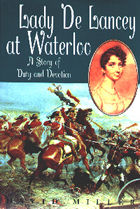Book
Review:
Lady de Lancey at Waterloo
Spellmount
By
David Miller
 One
of the great romantic tragedies is the story of Colonel William
de Lancey and his new bride Magdalene Hall.
One
of the great romantic tragedies is the story of Colonel William
de Lancey and his new bride Magdalene Hall.
The
lovers had a whirlwind romance and married three months prior
to the cataclysmic battle of Waterloo.
Obviously
in love, the couple cut a fine pair in society and stayed together
when De Lancey travelled to join the staff of the Duke of Wellington.
He had been asked for personally by Wellington and had an important
role to play in the 100 Days' Campaign.
Unfortunately,
De Lancey was mortally wounded by a cannonball during the battle
and suffered greatly for 11 days before succumbing to his injuries.
During
that time the devoted Magdalene tended her husband and later wrote
a journal about the period.
In
Lady de Lancey at Waterloo David Miller not only publishes
Magdalene Hall's narrative, but also looks at her life and the
life and career of Sir William de Lancey.
He
begins by tracing De Lancey's American family and tells how that
their support for Britain during the American Revolution cost
them dearly as they fell from being one of the richest clans in
the world to having to rebuild their fortunes from scratch.
De
Lancey's military life began as a 16-year-old in Holland, was
connected with the Quiberon expedition and he went on to serve
in the East Indies.
Ambitious
and talented, the young officer was the 53rd student at the staff
training centre Royal Military College.
Miller
traces De Lancey's rise through the ranks right through to his
becoming the Duke of Wellington's indispensible aide. He also
states that it was De Lancey and not Wellington who picked the
ground upon which Waterloo would be fought.
Turning
to Magdalene Hall he also examines her family background and then
presents her narrative.
Magdalene's eyewitness account of the lead-up to the battles of
Quatre Bras and Waterloo is interesting and shows that those accompanying
the British army were very nervous indeed about the upcoming fight
with Napoleon Bonaparte.
However,
it is her description of the events after her husband suffered
his horrendous wound - he was hit in the back by a richocheting
cannonball that tore eight ribs from his spine and drove one into
his lungs - and how she tried to nurse and comfort him that is
fascinating.
Not
only is it moving, but gives a great insight into what men injured
in battle had to go through.
After
returning to Britain, Magdalene eventually remarried and had three
children. The third birth seemed to have been a very difficult
one and led to her early death in 1822.
Two
of her descendants - her great-grandson and great-great grandson
- died fighting in World War I and World War II.
Lady
de Lancey at Waterloo may
not be the sort of book that is a first choice for Napoleonic
enthusiasts, however, for historical flavour - and as a tale of
love and devotion - it is worth reading.
-
Richard Moore
7.5/10